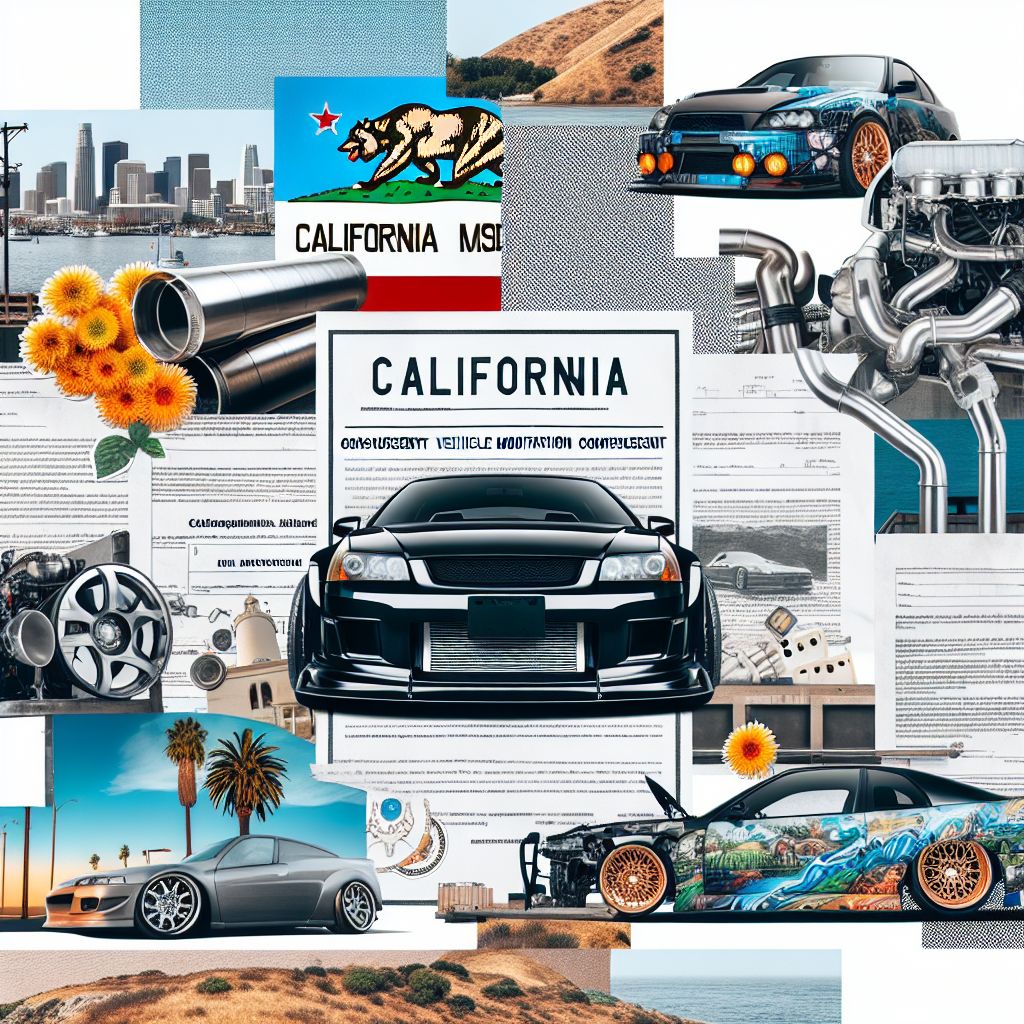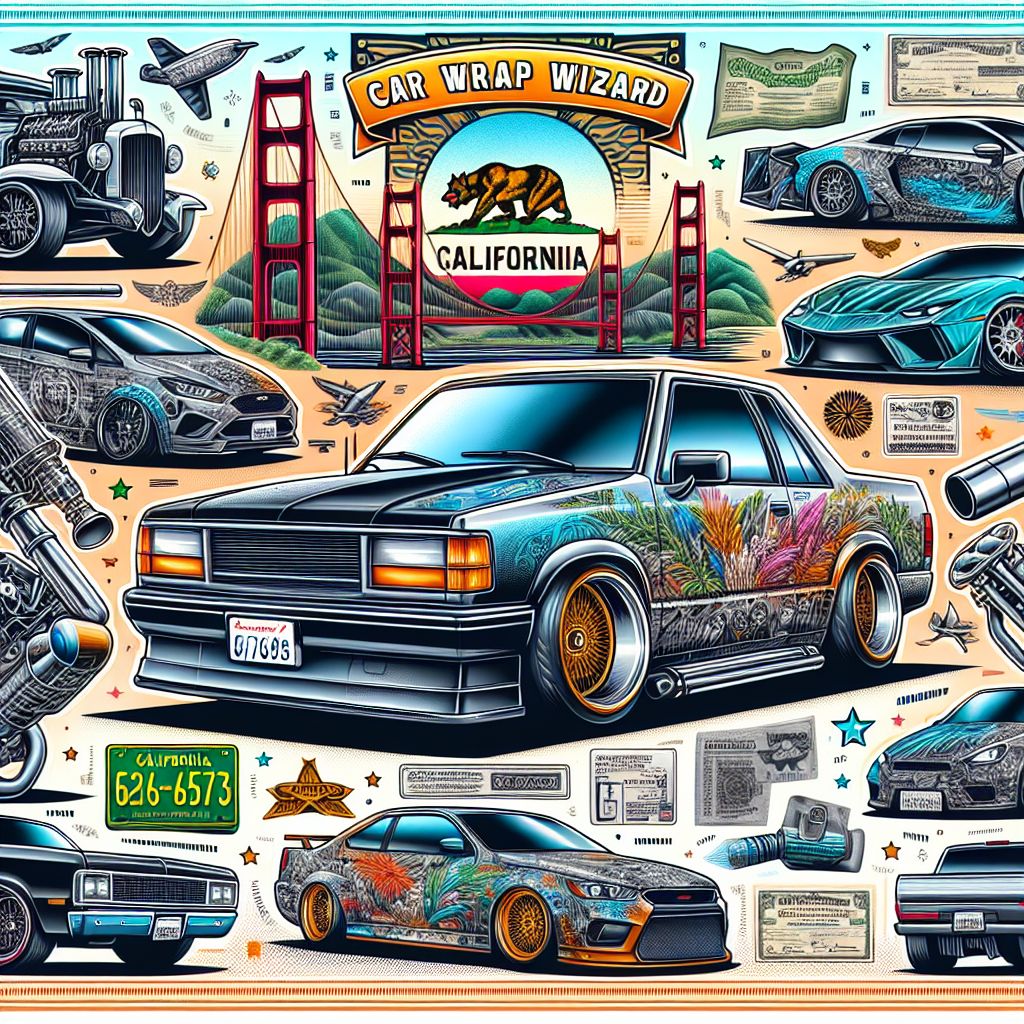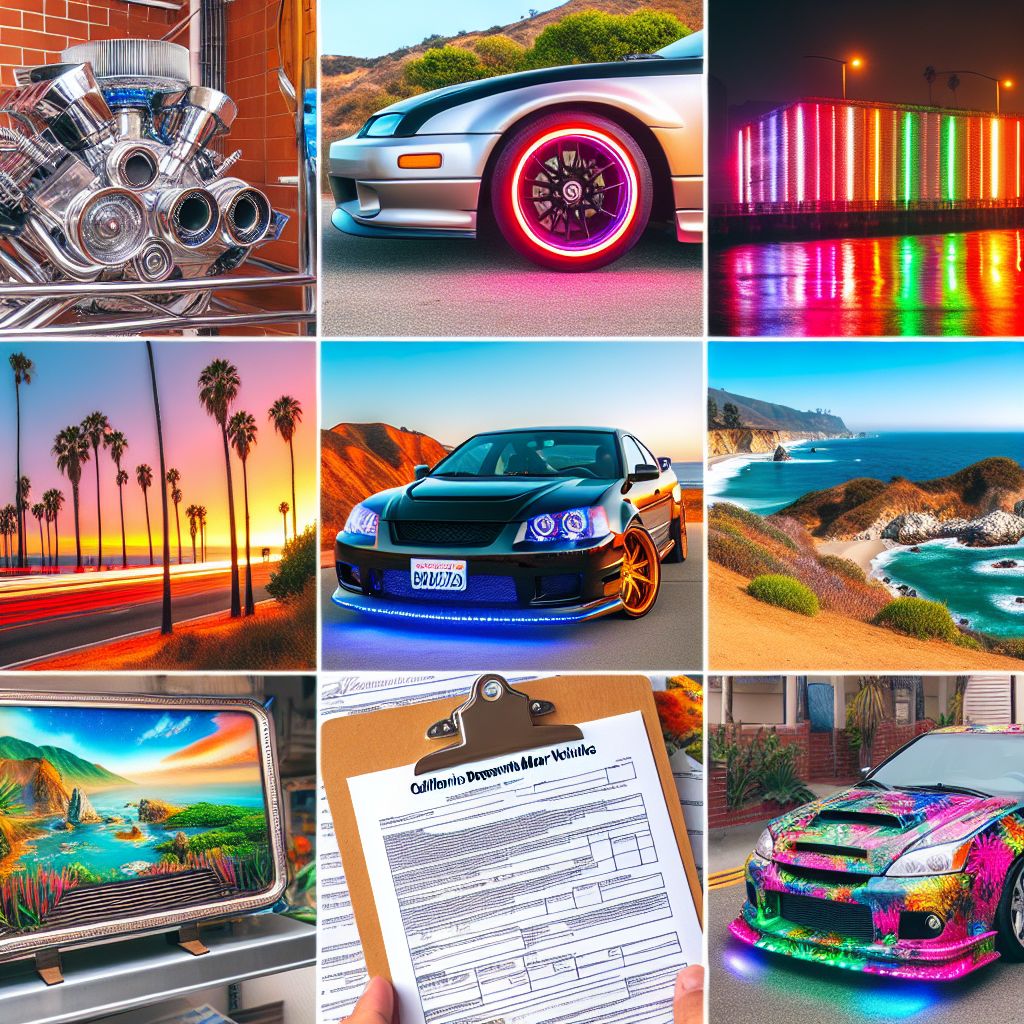
Key Takeways
- California’s vehicle modification rules prioritize emissions, safety, and lighting standards.
- Documenting your modifications with the DMV is crucial to avoid penalties.
- Modifications like engine swaps must use same or newer year engines and pass emissions tests.
- Illegal modifications include overly dark window tints and certain underglow lighting colors.
- Understanding which modifications are allowed can save you from fines and ensure road safety.
Understanding CA DMV Modification Guidelines
When it comes to personalizing your ride in California, it’s not just about making your car look cool or run faster. It’s about playing by the rules to ensure you’re not on the wrong side of the law. California DMV has some of the strictest vehicle modification laws in the country, and for good reasons. These laws are designed to protect the environment, ensure public safety on roads, and maintain order. But don’t worry, I’m here to guide you through these regulations so you can customize your vehicle without any legal hiccups.
First things first, you need to know what’s on the table. Can you swap out that engine? What about lifting your truck? Or tinting those windows? California allows many modifications, but they come with a set of requirements you need to follow strictly. Most importantly, any significant changes to your vehicle’s engine, emissions system, or structure must be reported to the California Department of Motor Vehicles (DMV).
What’s Allowed and What’s Not
Let’s break it down. You can modify your car’s engine, but you’ll need to ensure it’s the same or a newer year than your vehicle and that it meets all emissions standards. Suspension lifts? Sure, but there are height restrictions you’ll need to check. Lighting can be tricky; you’ll want to avoid certain colors and brightness levels. And those window tints? They need to let in a minimum amount of light to be legal.
Decoding the Legal Jargon
Besides that, it’s crucial to understand the legal language. Terms like ‘CARB compliant’ and ‘VLT percentage’ might sound technical, but they’re pretty straightforward once you get the hang of them. CARB stands for the California Air Resources Board, which regulates air pollution in the state. VLT, or Visible Light Transmission, is the percentage of light that can pass through your window tints. Knowing these terms will help you communicate better with modification providers and ensure you’re getting parts that are street-legal in California.
Roadworthy Mods: Staying Legal on the Streets of California
So you want to ensure your ride stands out, but also passes the smog test? It’s all about balance. Engine and emission modifications must comply with California’s smog laws. This means if you’re installing a new exhaust system, it can’t be louder than what the factory system allowed. The same goes for engine swaps; they must be done using components that won’t increase your car’s emissions.
Engine and Emission Mods: Passing the Smog Test
For example, if you’re considering a turbocharger or a supercharger, make sure it comes with a CARB Executive Order (EO) number, which means it’s approved for use in California. This number should be displayed on the part or its packaging. Without it, you’re likely to fail the smog check, and that can lead to fines and a lot of headaches with the DMV.
Lights and Sounds: Keeping It within Limits
Customizing your car’s lighting can give it a sleek look, but California has specific rules about this too. Headlights and taillights must meet certain brightness and color regulations. For instance, your headlights need to be white or yellow, and your taillights red. Underglow lighting is where many enthusiasts get tripped up. While it’s not entirely banned, colors like red and blue are off-limits because they’re reserved for emergency vehicles. And as for the sound of your car, that exhaust can’t roar too loudly. It’s not just about noise pollution; it’s about keeping the peace.

The Paper Trail: Documents You’ll Need for Your Mod Journey
After you’ve made your modifications, there’s some paperwork to take care of. You’ll need to provide the DMV with documentation of the changes. This includes a vehicle title and a statement of construction if you’ve made significant structural changes. And don’t forget, if your car looks different from what’s on record, you might need to get it verified by the DMV.
| Modification | Required Documentation |
|---|---|
| Engine Swap | California Certificate of Title, Vehicle Body Change Statement (REG 256), Evidence of Ownership for New Engine |
| Suspension Lift | Weight Certificate, Receipts for Parts and Labor |
| Window Tinting | Certificate of Compliance from Installer |
| Custom Lighting | Proof of Meeting California Brightness and Color Regulations |
| Exhaust System Upgrade | Certificate of Noise Compliance |
Registration and Titling Post-Modification
Once you’ve modified your vehicle, you may need to re-register it with the DMV. This is especially true if the modifications change the vehicle’s weight, engine type, or fuel type. You’ll need to fill out some forms, pay a fee, and provide evidence that your car is still safe to drive. Remember, this is for your benefit too. Proper registration means you’re less likely to run into trouble on the road.
Special Inspections and Certifications Explained
Some mods require a special inspection to ensure they’re up to code. For instance, if you’ve modified your car’s brakes or lights, you might need a brake and light inspection certificate. This proves that, despite the changes, your car can still stop effectively and be seen clearly by other drivers. It’s all about making sure that while your car turns heads, it doesn’t cause any accidents.
- Modifying suspension, tires, and brakes must prioritize safety and comply with California’s regulations.
- Structural changes to a vehicle can affect its rigidity and aerodynamics, which must be properly assessed.
- Choosing certified parts and reputable providers is key to a hassle-free modification process.
- Vehicle modifications can have implications for insurance coverage and premiums.
- Certain modifications are red flags and can lead to being pulled over or fined.
Performance and Safety: Tweaks That Meet the Streets
Modifying your car isn’t just about making it look good; it’s about enhancing its performance while ensuring it remains safe for everyone on the road. California law requires that any modifications to suspension, tires, and brakes not only comply with safety standards but also maintain or improve the original performance of the vehicle. This means that while you can lift your truck or add those low-profile tires, you must do so without compromising the vehicle’s safety features or handling characteristics.
Suspension, Tires, and Brakes: Balancing Mods with Safety
When modifying your vehicle’s suspension, it’s important to keep in mind that while raising or lowering your car can give it a more aggressive stance, it can also affect its center of gravity and handling. Similarly, swapping out tires for ones with a different size or tread pattern can alter the way your car grips the road. And when it comes to brakes, upgrading to a high-performance kit can offer better stopping power, but it must be compatible with your vehicle’s design.
Structural Changes: When Rigidity and Aerodynamics Collide
Structural modifications, such as adding a roll cage or changing the aerodynamics with a new spoiler, can provide benefits in terms of rigidity and stability. However, these changes can also affect your car’s performance, especially if they alter its aerodynamic profile. It’s essential to understand how these modifications interact with the rest of your vehicle to ensure they provide the intended benefits without any unintended consequences.
Customize with Confidence: Tips to Avoid DMV Hassles
When it comes to vehicle customization, doing it right means avoiding the DMV’s red tape. The key is to choose certified parts that comply with state regulations and to work with providers who understand California’s strict modification laws. This not only ensures that your car remains legal but also helps maintain its reliability and value.
Choosing Certified Parts and Providers
Always opt for parts that have been certified by the California Air Resources Board (CARB) or that come with a CARB Executive Order (EO) number. This is especially important for engine-related mods that can affect emissions. Besides, reputable providers will be up-to-date with the latest regulations and can help guide you through the modification process, ensuring that your vehicle passes any necessary inspections with flying colors.
Insurance Implications: Before and After Modification
Before you start modding, talk to your insurance provider. Modifications can affect your coverage and your premiums. For example, certain modifications may increase the risk of theft or damage, leading to higher insurance costs. On the flip side, safety improvements could potentially lower your premiums. Make sure you understand the full financial impact of your modifications before proceeding.
legal vehicle modifications allowed in California
Example legal vehicle modifications in California
| Modification Type | Requirements |
|---|---|
| Specially Constructed Vehicle (SPCNS) | – Submit application, vehicle verification, construction statement, bills of sale, brake/light certs, weight cert 3 |
| Body/Weight Changes over $2,000 | – Submit title, vehicle verification, body change statement, weight cert, part ownership evidence 1 2 |
| Suspension Lifts | – Limited to 5 inches above factory frame height 4 |
| Aftermarket Wheels, Tires, Shocks | – Must meet safety requirements 4 |
| Additional Lighting | – No more than 4 front lights on while driving 4 |
| Engine Changes | – Report to DMV, use same/newer year, meet emissions 4 |
| Sound System | – Can’t be heard 50 feet or over from vehicle 4 |
| Mufflers | – Can’t increase sound beyond factory levels, under 95 decibels 4 |
| Excessive Exhaust Noise | – Modifications that significantly increase noise are not allowed 4 |
References:
1 https://www.dmv.ca.gov/portal/handbook/vehicle-industry-registration-procedures-manual-2/corrections-and-adjustments/changing-the-body-type-model-btm-and-or-weight/
2 https://www.dmv.ca.gov/portal/handbook/vehicle-industry-registration-procedures-manual-2/commercial-vehicles/body-changes-and-alterations/
3 https://www.dmv.ca.gov/portal/vehicle-registration/new-registration/register-a-specially-constructed-or-modified-vehicle/
4 https://www.yourmechanic.com/article/the-guide-to-legal-car-modifications-in-california-by-valerie-mellema

Modifications with a RED Flag
While many mods can enhance your vehicle’s aesthetics and performance, some are surefire ways to attract unwanted attention from law enforcement. In California, certain modifications can lead to being pulled over, ticketed, or even having your car impounded.
Illegal Mods That Will Get You Pulled Over
Here are a few modifications that will set off alarm bells: To ensure your vehicle modifications are legal, check out this California car customization legality guide.
- Excessively loud exhaust systems that violate noise ordinances.
- Window tints with less than the legally required amount of VLT.
- Underglow lights that are restricted colors, such as red or blue, which are reserved for emergency vehicles.
- Illegal suspension lifts that exceed the state’s height restrictions.
Stay informed and play it safe. Modifying your vehicle can be a rewarding experience, but it’s important to do so within the confines of the law. By following California’s DMV rules and regulations, you ensure that your custom ride is both impressive and compliant, keeping the streets safe for everyone.
Illegal Mods That Will Get You Pulled Over
If you’re thinking of adding some flash to your car with underglow lights or darkening your windows for that sleek look, you’ll want to pump the brakes and consider this: not all mods are legal. In California, there are specific vehicle modifications that can attract the wrong kind of attention from law enforcement. Understanding these can help you avoid the inconvenience of being pulled over or, worse, receiving a citation.
Consequences of Non-Compliance: Fines and Penalties
Ignoring the rules isn’t worth it. If you’re caught with illegal modifications, you could face various penalties. These range from fines and having to remove the mods at your own expense to more severe consequences like having your vehicle impounded. Remember, the goal of these laws isn’t to curb your creativity but to keep everyone on the road safe.
For instance, an illegal exhaust modification that’s too loud might lead to a fine. If you don’t correct the issue, you could be looking at repeat fines or even a court appearance. It’s best to stick to the straight and narrow, modifying your vehicle in ways that meet legal standards
Example Illegal vehicle modifications in California
| Illegal Modification | Reason |
|---|---|
| Extremely Dark Window Tints | – Reduces visibility, illegal in California 1 |
| Red, Blue, or Amber Window Tints | – Prohibited colors, considered illegal modifications 1 |
| Extremely Bright Underglow Lighting | – Excessively bright lighting is not allowed 1 |
| Red Lights at Front of Vehicle | – Installation of red lights at the front is prohibited 1 |
| TV Screens in Driver’s View | – Having TV screens in the driver’s direct line of sight is illegal 1 |
| Modifications Increasing Exhaust Noise | – Aftermarket exhaust cannot significantly increase noise beyond factory levels 1 2 |
| Hanging Items Obstructing Driver’s View | – Anything hanging from the rearview mirror that blocks visibility is not permitted 1 |
| Engine Modifications Affecting Emissions | – Engine changes must meet California’s emissions standards 3 4 |
| Increasing Vehicle Height Beyond Limits | – There are strict limits on how high a vehicle’s body can be raised 3 5 |
References:
1 https://pedalcommander.com/blogs/garage/these-9-mods-are-illegal-in-california
2 https://www.cbr250.net/threads/california-laws-on-motorcycle-modifications.2680/
3 https://www.dmv.ca.gov/portal/vehicle-registration/new-registration/register-a-specially-constructed-or-modified-vehicle/
4 https://www.dmv.ca.gov/portal/handbook/vehicle-industry-registration-procedures-manual-2/new-vehicles-sold-by-california-dealers/new-vehicles-altered-before-registration/
5 https://www.dmv.ca.gov/portal/handbook/vehicle-industry-registration-procedures-manual-2/corrections-and-adjustments/changing-the-body-type-model-btm-and-or-weight/
The key reasons these modifications are illegal in California are related to safety, noise, emissions, and preventing confusion with emergency vehicles. Owners must ensure their vehicle modifications comply with the state’s strict vehicle code.

Frequently Asked Questions (FAQ)
Can I install neon underglow lights on my car in California?
- Yes, but with restrictions. The lights must not be red, blue, or amber, as these are reserved for emergency vehicles.
- The lights cannot flash or include any movement.
- The installation must not emit light directly upwards.
- The lights should not be visible from the front of the car to avoid confusion with emergency vehicles.
Stick to these guidelines, and you should be able to enjoy your underglow without any issues from law enforcement.
It’s important to keep your modifications tasteful and within legal boundaries. While customizing your car can be a form of self-expression, ensuring that it aligns with California’s DMV rules will keep you out of trouble and your car on the road.
Remember, the key to successful vehicle modification is knowledge and compliance. By understanding and adhering to the rules set forth by the California DMV, you can enjoy a car that’s not only personalized to your tastes but also safe and legal to drive on public roads.
Do I need to notify the DMV if I upgrade my exhaust system?
Yes, if the modification affects the noise level of your exhaust, you’re required to ensure it’s within California’s legal noise limits. While you don’t need to notify the DMV of every minor change, significant alterations that could affect the vehicle’s emissions or noise levels should be documented.
If your new exhaust system is louder than the stock system, you might need a certificate of compliance for noise. This helps prove that your car still meets the state’s noise regulations after the modification.
How high can I lift my truck before it’s considered illegal?
In California, the maximum frame height and bumper height depend on the vehicle’s gross vehicle weight rating (GVWR). Generally, vehicles with a GVWR of less than 4,500 pounds have a maximum frame height of 27 inches and a bumper height of 22 inches. As the GVWR increases, so do the allowable heights, but there are limits. Always check the most current regulations before lifting your truck to ensure compliance.
Are window tints with less than 70% visibility allowed in CA?
No, California law requires that the front driver’s and passenger’s side windows must allow more than 70% of the light to pass through. Tints darker than this can result in a ticket. For rear windows, any darkness can be used if your vehicle has outside rearview mirrors on both sides.
Is it mandatory to get a brake and light inspection after modifications?
If you’ve made modifications to the brake system or the lighting of your vehicle, California may require a brake and light inspection to ensure that these critical systems are still operating correctly. This is to certify that your car is safe to drive and complies with state safety standards. It’s not just a formality; it’s about ensuring your safety and the safety of others on the road.





Leave a Reply